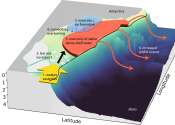First observation made of quantum-tunneling diffusion of hydrogen atoms on ice
(Phys.org)—As long as the temperature is above absolute zero, gas molecules are always in constant random motion. They may diffuse—or spread out—through three-dimensional space or, in a process called "surface diffusion," ...









